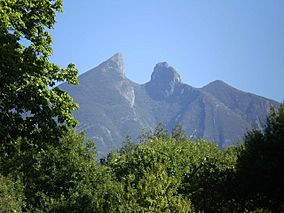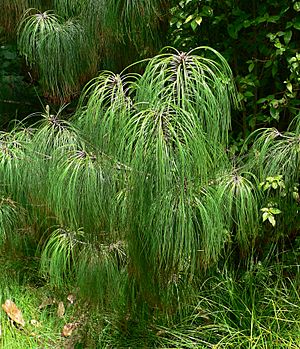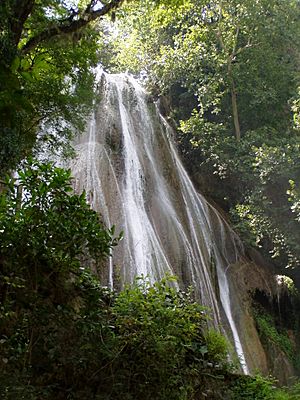Cumbres de Monterrey National Park facts for kids
Quick facts for kids Cumbres de Monterrey National Park |
|
|---|---|
| Parque Nacional Cumbres de Monterrey | |
|
IUCN Category II (National Park)
|
|

El Cerro de la Silla is the most famous part of the national park
|
|
| Location | Nuevo León and Coahuila, Mexico |
| Nearest city | Monterrey, Nuevo León |
| Area | 177,395.95 hectares (438,354.9 acres) |
| Established | November 24, 1939 |
| Administrator | National Commission of Natural Protected Areas |
The Cumbres de Monterrey (meaning "Summits of Monterrey" in English) is a large national park in Mexico. It is located in the northern part of the Sierra Madre Oriental mountains. You can find it near the city of Monterrey in the states of Nuevo León and Coahuila.
This park protects over 1,770 square kilometres (680 sq mi) of amazing natural land. It has deep canyons, flowing rivers, beautiful waterfalls, and tall mountain peaks. One of its most famous peaks is Cerro de la Silla ("Saddle Mountain"). This mountain is a well-known part of Monterrey's skyline.
The park was created in 1939 by President Lázaro Cárdenas. Its main goal was to protect the plants and animals living there. It also helped stop the city of Monterrey from growing too much into these natural areas. The park's cool pine and oak forests offer many trails. It is a popular place for people to escape the busy city.
Contents
History of the Park
People have lived in the Cumbres de Monterrey area for thousands of years. We know this from ancient paintings and stone carvings found throughout the park. Before the Spanish arrived, different groups of Chichimeca people lived here. Many tribes worked together to avoid Spanish rule for years. The city of Monterrey was founded on September 20, 1596. It was the first European settlement in the area.
Cumbres de Monterrey National Park was officially created on November 24, 1939. President Lázaro Cárdenas made it a protected area. At first, it was 246,500 hectares (609,000 acres) big. This made it the largest national park in Mexico at that time. Later, on November 17, 2000, the park's size was changed. It became 177,395.95 hectares (438,354.9 acres).
Exploring the Geography

One easy-to-reach part of Cumbres de Monterrey is Chipinque. It is right on the edge of Monterrey, about 19 kilometres (12 mi) from the city center. At the visitor's center, you can get maps and information. There are many hiking trails, from easy walks to more challenging paths. Chipinque is a special ecological reserve within the park. It lets visitors easily see many of the plants and animals found in the park.
The park is in the northern part of the Sierra Madre Oriental mountains. These mountains were formed millions of years ago. Marine rocks folded and rose up to 2,260 m (7,410 ft) above sea level.
Mountain Peaks
Some of the highest peaks in the park include:
- Pinar: 1,515 m (4,970 ft) above sea level
- Cerro de la Silla: 1,820 m (5,970 ft) above sea level
- La Ventana: 1,955 m (6,414 ft) above sea level
- La Antenna: 2,015 m (6,611 ft) above sea level
- M Este: 2,020 m (6,630 ft) above sea level
- Copete de las Águilas: 2,260 m (7,410 ft) above sea level
Caves and Underground Rivers
The mountains in the park are mostly made of sedimentary rock from the Cretaceous period. Over millions of years, this rock developed many holes and channels. This process is called karstification. It created amazing underground systems, like rivers, caves, and places where water collects underground (aquifers).
The Grutas de García (García Caves) are a famous attraction in the park. They are one of the largest cave systems in Mexico. These caves were hidden for millions of years. They were discovered in 1843. Scientists have found marine fossils inside the caves. This is because the cave walls are made of old ocean sedimentary rock. The rocky ground in the park lets water filter down into underground rivers. These rivers fill up the aquifers, which provide a lot of water for Monterrey city.
Pozo del Gavilán (Eagle's Hole) is another cool example of karstification. It is the only cenote (a natural pit, or sinkhole) known in northern Mexico. Pozo del Gavilán is a popular spot for rappelling. It is also connected underground to Laguna de Labradores (Labradores Lake).
Canyons and Waterfalls
Cañón de la Huasteca is the most famous canyon in Cumbres de Monterrey. It covers about 200 hectares (490 acres) of the park. The canyon walls have many ancient carvings called glyphs. These were made thousands of years ago by the first people who lived here. Matacanes Canyon is another popular canyon. It has several waterfalls, and Cascada de Chipitín (Chipitín Falls) is the most well-known.
The park has many waterfalls. There might even be more hidden ones. This is because a large cave system holds a lot of water. This water flows through underground rivers instead of on the surface. The two most famous waterfalls are Cascada Cola de Caballo (Horsetail Falls) and Cascada de Chipitín.
Horsetail Falls is easy to reach by a trail. It is a highlight of the park, with water dropping 25 m (82 ft) over rounded rocks. It looks just like a horse's tail! Chipitín Falls is harder to get to. It needs a tough hike, some rappelling, and swimming. This waterfall has an impressive 27 m (89 ft) drop. Besides rivers and waterfalls, there are also many ponds and small lakes. The best-known lake is Laguna de Labradores.
Climate in the Park
The weather in Cumbres de Monterrey National Park changes a lot. It depends on how high up you are and where you are in the park. Different parts of the park have different climates.
- Elevations from 600–1,000 m (2,000–3,300 ft): The northern tip of the park has a desert climate. The average temperature is 23 °C (73 °F), and it gets about 21.7 cm (8.5 in) of rain each year. The southeast and central-east parts have a tropical savanna climate. Winters are mild, and there's a lot of rain in summer and autumn. The average temperature is 21 °C (70 °F), with 106.4 cm (41.9 in) of rain yearly.
- Elevations from 1,000–2,000 m (3,300–6,600 ft): The northern tip and southwest corner have a steppe climate. The average temperature is 21 °C (70 °F). The central part has a humid subtropical climate. The average temperature is 21 °C (70 °F), and it gets about 62 cm (24 in) of rain each year.
- Elevations from 2,000–3,000 m (6,600–9,800 ft): The western side of the park has an oceanic climate. The average temperature is 14 °C (57 °F), and it gets about 68 cm (27 in) of rain each year.
Plants and Animals

Cumbres de Monterrey National Park has many different kinds of plants and animals. This is because the park's geography creates many small climates. These different climates allow a wide variety of life to grow. You can find Agave, Dasylirion, and Rhus plants in many areas.
Trees
The forests are mainly made up of these tree types:
- Spruce: Picea martinezii, Picea engelmannii
- Yucca: Yucca carnerosana, Yucca filifera
- Douglas fir: Pseudotsuga lindleyana, Pseudotsuga flahualti
- Fir: Abies vejarii, Abies hickelii, Abies hidalgensis, Abies durangensis
- Oak: Quercus fusiformis, Quercus greggii, Quercus hipoxlanta, Quercus laeta, Quercus saltillensis
- Pine: Pinus ayacahuite, Pinus cembroides, Pinus greggii, Pinus hartwegii, Pinus pinceana, Pinus pseudostrobus, Pinus rudis, Pinus teocote
Wildlife
The pine and oak forests are home to many animals. This park has one of the most diverse ecosystems in northern Mexico.
Fish
There are many kinds of fish in the park, but most are endangered. Some fish species found here include Astyanax mexicanus, Campostoma anomalum, Cichlasoma cyanoguttatum, and Gambusia affinis. Only a few fish species are found nowhere else in the world. These include Cyprinella rutila, Dionda melanops, and Moxostoma albidum. Many Cyprinodon species still exist, but many are endangered or have disappeared.
Birds
The park is home to many bird species. Some examples are Accipiter striatus (Sharp-shinned Hawk), Aquila chrysaetos (Golden Eagle), Circus cyaneus (Northern Harrier), and Falco peregrinus (Peregrine Falcon). You might also see the Rhynchopsitta terrisi (Maroon-fronted Parrot).
Mammals
Mammals living in the park include Puma concolor (Puma), Ursus americanus (American Black Bear), Canis latrans (Coyote), and Odocoileus virginianus (White-tailed Deer).
Images for kids
-
Mexican Tetra (Astyanax mexicanus)
-
Northern Harrier (Circus cyaneus)
See also
 In Spanish: Parque nacional Cumbres de Monterrey para niños
In Spanish: Parque nacional Cumbres de Monterrey para niños







